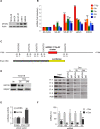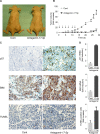Antagomir-17-5p abolishes the growth of therapy-resistant neuroblastoma through p21 and BIM
- PMID: 18493594
- PMCID: PMC2375057
- DOI: 10.1371/journal.pone.0002236
Antagomir-17-5p abolishes the growth of therapy-resistant neuroblastoma through p21 and BIM
Abstract
We identified a key oncogenic pathway underlying neuroblastoma progression: specifically, MYCN, expressed at elevated level, transactivates the miRNA 17-5p-92 cluster, which inhibits p21 and BIM translation by interaction with their mRNA 3' UTRs. Overexpression of miRNA 17-5p-92 cluster in MYCN-not-amplified neuroblastoma cells strongly augments their in vitro and in vivo tumorigenesis. In vitro or in vivo treatment with antagomir-17-5p abolishes the growth of MYCN-amplified and therapy-resistant neuroblastoma through p21 and BIM upmodulation, leading to cell cycling blockade and activation of apoptosis, respectively. In primary neuroblastoma, the majority of cases show a rise of miR-17-5p level leading to p21 downmodulation, which is particularly severe in patients with MYCN amplification and poor prognosis. Altogether, our studies demonstrate for the first time that antagomir treatment can abolish tumor growth in vivo, specifically in therapy-resistant neuroblastoma.
Conflict of interest statement
Figures







References
-
- He L, Hannon GJ. MicroRNAs: small RNAs with a big role in gene regulation. Nat Rev Genet. 2004;5:522–531. - PubMed
-
- Bartel DP. MicroRNAs: genomics, biogenesis, mechanism, and function. Cell. 2004;116:281–297. - PubMed
-
- Zhao Y, Srivastava D. A developmental view of microRNA function. Trends Biochem Sci. 2007;32:189–197. - PubMed
-
- Valencia-Sanchez MA, Liu J, Hannon GJ, Parker R. Control of translation and mRNA degradation by miRNAs and siRNAs. Genes Dev. 2006;20:515–524. - PubMed
Publication types
MeSH terms
Substances
LinkOut - more resources
Full Text Sources
Other Literature Sources
Medical

